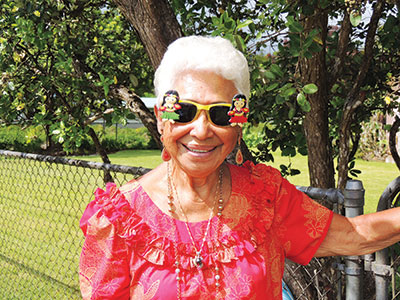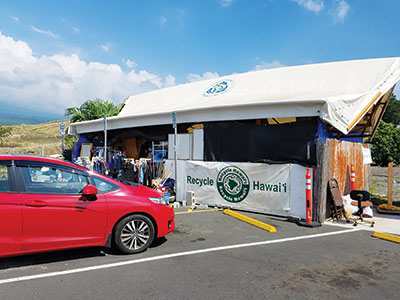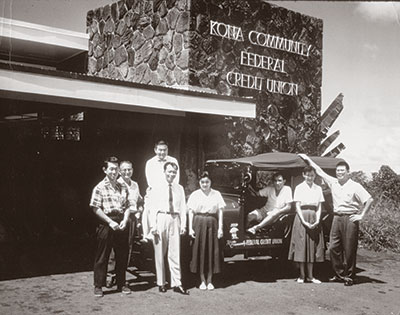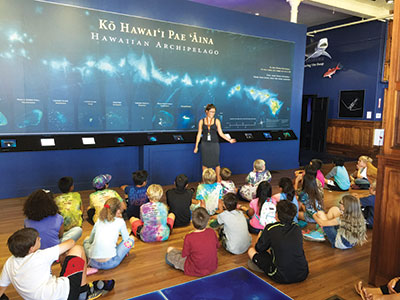
How to See Papahānaumokuākea–And How to Say It!
 By Karen Valentine
By Karen Valentine
From exploring and visiting a real gem of a visitors’ attraction in Hilo.
Mokupāpapa Discovery Center is the primary interpretive center for the Northwest Hawaiian Islands Marine National Monument—more correctly named Papahānaumokuākea Marine National Monument. Not only is it located in an exquisite historical building with a rich history in itself, its exhibits are interesting and intriguing to all ages. (see story on page 34)
Before we jump into learning about the Discovery Center, let’s tackle the name pronunciation issue. It helps to first split up the words into parts and understand their meanings in Hawaiian. Mokupāpapa starts with the word “moku” (mo-koo). It means island in Hawaiian. Pāpapa (pah-pah-pah) means a place that is low or flat, such as an ocean reef. In this case, Mokupāpapa is a description of all the tiny atolls, islands and reefs that make up Papahānaumokuākea National Monument. Yes, another, even longer word!
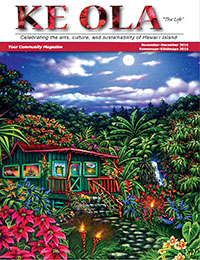
OK, you notice that Papahānaumokuākea has that word “moku” in the middle, meaning island. It’s actually the name for a string of 10 islands, atolls, and numerous smaller sandy islets, beginning northwest of Kaua‘i and Ni‘ihau and extending 1,200 miles, all the way to the atolls of Midway and Kure, which are famous for a WWII naval battle. These are the Northwest Hawaiian Islands.
Split up the name: Papa-hānau-moku-ākea
(pronounced Pa-pa-hah-now-mo-koo-ah-keh-ah). There are four words that make up the one big one. Taken apart it can translate as; “Papa” (earth mother), “hānau” (birth), “moku” (island), and “ākea” (wide or sky father). It describes a fertile woman giving birth to a wide stretch of islands beneath a benevolent sky.
The name Papahānaumokuākea was devised from the ancient Hawaiian story of the genealogy and formation of the Hawaiian Islands. Papahānaumoku is a mother figure personified by the earth and Wākea is a father figure personified in the expansive sky; the two are honored and highly recognized ancestors of Native Hawaiian people.
“Their union resulted in the creation, or birthing, of the entire Hawaiian archipelago––thus the naming of the monument is to honor and preserve these names, to strengthen Hawai‘i’s cultural foundation and to ground Hawaiians to an important part of their history.
It also is a symbol of hope for the continuing regeneration of Hawai‘i from the kūpuna islands in the far northwest to the youngest, the island of Hawai‘i,” said Virginia Branco, interim director of the Discovery Center.
The center’s location in Hilo is appropriate as it is close to where the newest island, Lō‘ihi, is still being formed, on the opposite end of the island chain from the kūpuna or oldest islands to the northwest.
Since most people will never have the opportunity to visit these remote islands, the center seeks to “bring the place to the people” and spur greater public awareness of the region and ocean conservation issues.
“Hilo is also a good location because of its connection with Hawai‘i Volcanoes National Park and all the visitors coming here,” Virginia says.
“In our new facility, the nature and culture of the Northwestern Hawaiian Islands come alive as never before, transporting visitors to this remote ocean wilderness where predators rule the reefs, the skies teem with swooping, screeching seabirds, and the Native Hawaiian chanting of the Kumulipo (Hawaiian creation chant) sets the mood for exploration and learning,” states the Mokupāpapa website.
The Mokupāpapa Discovery Center (MDC) was first established in 2003 in a small space in the S. Hata Building in downtown Hilo. In 2014, it was expanded and moved into the much-larger Koehnen Building on the corner of Kamehameha and Waiānuenue Avenues.
Most people remember the building as the home of Koehnen’s Furniture, an 87-year-old family business headed by now-92-year-old Fred J. Koehnen. With no family members wishing to continue in the business, the patriarch sold the building to Giuseppe “Joe” Mamone, who leases it to the MDC. The historic structure was built in 1910 by H. Hackfield, a German immigrant who lost the building in 1916 when World War I was beginning and it was confiscated by the U.S. government, which considered the property an enemy-owned asset. It was then sold to an O‘ahu sugar company, American Factors (Amfac). Amfac moved out following Hilo’s 1946 tsunami and the building stood vacant for several years before its purchase by Koehnen and his brother-in-law, Carl Rohner.
Subsequently, the solid structure and furniture store survived another tsunami in 1960. Architectural features, including a koa wood staircase (designed by the same artisan that did the famous Titanic staircase), Hawaiian hardwood floors, and high ceilings have been well preserved and integrated with the MDC exhibits and presentation areas.
“We were really excited to get this place,” said Andy Collins, education programs coordinator for the center. “It was an opportune time. We were really looking to get out of our old location and we love the building. We’ve gotten a lot of comments from people who come to see the exhibit and remember the building and what it was like in their childhood. People start to cry—they’ll say, ‘Wow, I remember this place, thank you for restoring it.’ So that wasn’t intended, but it’s been really neat.”
“We are blessed with this large opportunity to come into this building,” says Virginia.
The center encompasses approximately 30,000 square feet of total space. A large room on the second floor may be booked for special functions.
“We offer the facility to other organizations. It has been used for conferences, especially those focused on marine or conservation issues. The event room holds 225 people. With downstairs spaces included, we have had up to 700 people at past events.”
Busloads of school children often arrive on the corner of Kamehameha and Waiānuenue to explore the center.
“We get anything from home school groups, Tūtū and Me preschool visitors, as well as elementary, high school, university classes, and some visiting from other islands and out of state. The first month we were open, 42 school groups visited. We have had significant numbers all year long,” says Virginia.
The staff has created a series of educational games and handouts for children, who can join the Ocean Guardian Club. It’s a self-directed project, in which they finish the activities in a booklet and then take a pledge to care for the ocean.
Mokupāpapa welcomes volunteers, which they call “mea kōkua.” They may be adults, retirees, interns from UH-Hilo, or high school students doing senior projects.
With the help of volunteers, the center can do outreach into schools and presentations at local events. Groups may also meet at the center or down by the ocean for education and tide pool activities.
A 3,500-gallon saltwater aquarium is a major exhibit at Mokupāpapa. It is managed by a professional aquarist (fish and aquatic caretaker), Tim Brown, who “has been caretaking aquariums for many years,” he says.
The aquarium is filled with artificial seawater, which is kept in pristine condition. Tim described the process: he begins with tapwater filtered with reverse osmosis and deionization, adding a synthetic sea salt.
“It is a closed system. We can’t use seawater from Hilo Bay. One of the reasons is that it has so much fresh water in it. We have more than 100 fish collected from the wild under strict permitting guidelines within the marine monument. They are caught as juveniles and quarantined, treating them for parasites and any health issues before adding them to the aquarium. Some of the fish in our aquarium are found only in Papahānaumokuākea. Some are found there and elsewhere. Two of the species here have never before been collected alive and in captivity. Several of them are unknown and still being studied.”
“In all of our years, we’ve had a very healthy tank, keeping fish for a long time,” says Virginia.
“Visitors get a chance to see these fish in their natural environment, as closely as possible,” Tim says. “You’d be surprised how many kids born and raised here have never been in the ocean. They don’t even know what’s under the water.”
The extensive coral reefs found in Papahānaumokuākea are home to more than 7,000 marine species, one quarter of which are found only in the Hawaiian Archipelago.
Many of the islands and shallow water environments are important habitats for rare species such as the threatened green sea turtle, the endangered Hawaiian monk seal, three endangered whale species, the endangered leatherback and hawksbill sea turtles, as well as the 14 million seabirds representing 22 species that breed and nest there.
Land areas also provide a home for four species of birds found nowhere else in the world, including the world’s most endangered duck, the Laysan duck.
Interactive educational exhibits at the Discovery Center let visitors explore these amazing islands in different ways.
“Exhibits showcase the latest research going on in the monument as they find new species,” says Virginia. “A collaboration between Liquid Robotics, Inc. and UH-Hilo features the Wave Glider, which collects weather and water quality data from ocean currents. We also have life-size models of wildlife found in the Northwestern Hawaiian Islands, artwork inspired by those islands and Hawaiian culture, and many interpretive panels in both Hawaiian and English. New features and new educational programs are being added.”
Papahānaumokuākea Marine National Monument is the largest contiguous, fully-protected conservation area in the world. It is co-managed by the National Oceanic and Atmospheric Administration, the U.S. Fish and Wildlife Service and the State of Hawai‘i, plus the Office of Hawaiian Affairs (OHA).
The Northwestern Hawaiian Islands Marine National Monument was established by Presidential Proclamation 8031 on June 15, 2006 under the authority of the Antiquities Act. Just this year, it was expanded in area as of August 26, when President Obama signed a proclamation expanding the Monument from 139,797 to 582,578 square miles of the Pacific Ocean—an area larger than all the country’s national parks combined. It is also the nation’s first and only mixed natural and cultural UNESCO World Heritage Site.
Commercial fishing and other resource extraction activities, which are currently prohibited within the boundaries of the existing monument, are also prohibited within the expanded monument boundaries.
Noncommercial fishing, such as recreational fishing and the removal of fish and other resources for Native Hawaiian cultural practices, is allowed in the expansion area by permit, as is scientific research.
Mokupāpapa Discovery Center is located at the corner of Kamehameha and Waiānuenue Ave. in Hilo. Regular business hours are Tuesday through Saturday from 9am–4pm. Admission is free.
You can take virtual tours of the major islands with Google Street View. Go to Virtual Tour on the website: Papahanaumokuakea.gov/education/center.html ❖
Contact writer Karen Valentine: karenvalentine808@gmail.com
Photos courtesy Mokupāpapa Discovery Center
